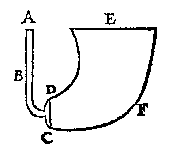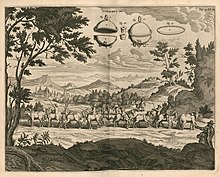Pressure
In physics, pressure is the result of a force 


The pressure on a body is positive if the force is directed towards it, a negative pressure corresponds to a pull. According to Pascal's principle (by Blaise Pascal), pressure in liquids and gases at rest (fluids) spreads out in all directions and, according to Euler, acts in the volume in all directions but always perpendicular to walls. The usual formula symbol p is based on the Latin or English word for pressure (Latin pressio, English pressure).
Pressure is an intensive, scalar physical quantity that plays an important role in fluid mechanics and thermodynamics in particular. The ratio of force to area is more precisely the mechanical pressure, which is a normal stress (a special case of mechanical stress) acting equally in all spatial directions. The thermodynamic pressure is a state variable, which is defined for a gas with an equation of state, and can deviate from the mechanical pressure in the case of disequilibrium.
The Pauli principle of quantum physics leads to a degeneracy pressure in fermions, which, for example, saves a white dwarf star from further collapse. According to general relativity, pressure also contributes to the gravitational effect.
The spatial dependence of pressure is often referred to as the pressure field, since pressure is a scalar field.

Here the force F is perpendicular to the surface A
History
In antiquity, Archimedes, Ctesibios, Philon of Byzantium, Heron of Alexandria and Sextus Iulius Frontinus were already aware of the effect of the pressure of water and air. In the Middle Ages, Alhazen should be mentioned, who had a correct idea of air pressure before in the Renaissance the Dutch merchant Simon Stevin (1548-1620) formulated the first principles of hydrostatics and the hydrostatic paradox, see picture.
Fundamental research began in the 17th century at the court of Grand Duke Cosimo II de' Medici. There, the well master was astonished to discover that he could not lift water higher than 32 feet (10.26 m) using a suction pump. An airless space formed above the column of water - as in the pipe in the picture in the area A-C - which prevented it from rising any higher. This phenomenon was reported to Cosimo II's teacher and court mathematician, Galileo Galilei, who subsequently treated it in his Discorsi (pp. 16-17). Vincenzo Viviani, an associate of Galileo, was the first to conclude in 1643 that it is air pressure that pushes the water up the suction tube (pictured at B). Evangelista Torricelli, Galileo's assistant and successor, made experiments with a tube filled with mercury as in the picture and explained from the difference in density of water and mercury why the former rises 13½ times higher than the latter at 760 mm. Thus Torricelli invented the mercury barometer.
The news of the "Italian experiment" came to Blaise Pascal in 1644 via Marin Mersenne and the physicist Pierre Petit. The latter repeated Torricelli's experiments and concluded that the pressure in a liquid or gas is proportional to its depth. Accordingly, if the column of mercury is carried by atmospheric pressure, its height on a mountain must be less than in the valley. Petit and Pascal's brother-in-law Florin Périer made the corresponding measurements at Clermont-Ferrand and on the summit of the 1465 m high Puy de Dôme on 19 September 1648 and obtained the expected results. Already in October Pascal published his results as a report of the great experiment on the equilibrium of liquids (Pascal: Récit de la grande expérience de l'équilibre des liqueurs). In the treatise on the equilibrium of liquids and on the weight of the mass of air of 1653, Pascal formulated among other things
- Pascal's principle, according to which pressure spreads out in all directions in liquids at rest,
- Pascal's law for hydrostatic pressure, which increases linearly with depth, see below, and
- the operating principle of a new machine for multiplying forces (Pascal: machine nouvelle pour multiplier les forces), i.e. the hydraulic press.
Otto von Guericke demonstrated his famous experiment with the Magdeburg hemispheres in front of the Reichstag in Regensburg in 1654, see picture.
New findings came from, among others
- Robert Boyle and Edme Mariotte in 1662 by the act of Boyle-Mariotte,
- Daniel Bernoulli in 1738 by tracing the pressure of gases back to the collisions of the gas molecules (kinetic theory of gases) and by distinguishing between hydrostatic and hydrodynamic pressure (Bernoulli pressure equation),
- Leonhard Euler with his definition of pressure within a fluid in its still valid form, i.e. that it acts within the volume in all directions but always perpendicular to walls, and
- John Dalton 1802 by discovery of the partial pressures of gases in gas mixtures (Dalton's law)

Hydrostatic paradox according to Stevin: The little water in the area ABCD of the vessel presses against the wall CD just as strongly as the much water in CDEF.

Stitch of Guericke's hemisphere attempt

Definition
Pressure is the result of a force acting on a surface. The magnitude of the pressure on the reference surface A results exclusively from the force component 
For curved surfaces or location-dependent pressure, a sufficiently small area element dA must be considered:
with:
| | - squeeze |
| | - Normal force and |
| | - Surface on which the force acts. |
Vectorially, the pressure is the constant of proportionality between the vector surface element 


The normal unit vector 
Occasionally it is said that pressure acts in a certain direction. Physically, it would be more correct to speak of the pressure force, which can press in one direction. In physics, however, pressure as a scalar quantity is directionless or "acting in all directions".
For incompressible and for compressible fluids, different components contribute to the total pressure. For free-flowing fluids, incompressibility can be assumed to a good approximation at velocities far below the wave propagation velocity, especially in liquids. Quiescent gases, on the other hand, are compressible.
Search within the encyclopedia




